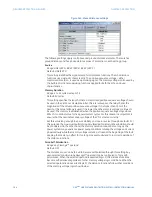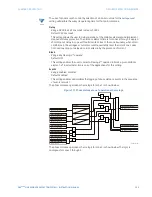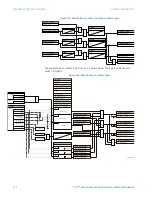
184
D90
PLUS
LINE DISTANCE PROTECTION SYSTEM – INSTRUCTION MANUAL
GROUPED PROTECTION ELEMENTS
CHAPTER 7: PROTECTION
Figure 161: Shared distance settings
The following settings apply to all phase and ground distance elements. There are five
ground distance and five phase distance zones of protection in each setting group.
Source
Range: LINE (SRC 1), BKR 1 (SRC 2), BKR 2 (SRC 3)
Default: LINE (SRC 1)
This setting identifies the signal source for all distance functions. The mho distance
functions use a dynamic characteristic. The positive-sequence voltage – either
memorized or actual – is used as a polarizing signal. The memory voltage is also used by
the built-in directional supervising functions applied for both the mho and quad
characteristics.
Memory Duration
Range: 5 to 25 cycles in steps of 1
Default: 10 cycles
This setting specifies the length of time a memorized positive-sequence voltage should
be used in the distance calculations. After this interval expires, the relay checks the
magnitude of the actual positive-sequence voltage. If it is higher than 10% of the
nominal, the actual voltage is used; if it is lower, then the memory voltage continues to
be used. The memory is established when the positive-sequence voltage stays above
80% of its nominal value for five power system cycles. For this reason it is important to
ensure that the nominal secondary voltage of the VT is entered correctly.
Set this value long enough to ensure stability on close-in reverse three-phase faults. For
this purpose, the maximum fault clearing time (breaker fail time) in the substation should
be considered. On the other hand, the memory duration cannot be too long as the
power system may experience power swing conditions rotating the voltage and current
phasors slowly while the memory voltage is static, as frozen at the beginning of the fault.
Keeping the memory in effect for too long may eventually lead to incorrect operation of
the distance functions.
Force Self-Polarization
Range: any FlexLogic™ operand
Default: OFF
The distance zones can be forced to become self-polarized through this setting. Any
user-selected condition (any FlexLogic™ operand) can be configured to force self-
polarization. When the selected operand is asserted (logic 1), the distance functions
become self-polarized regardless of other memory voltage logic conditions. When the
selected operand is de-asserted (logic 0), the distance functions follow other conditions
of the memory voltage logic shown below.









































